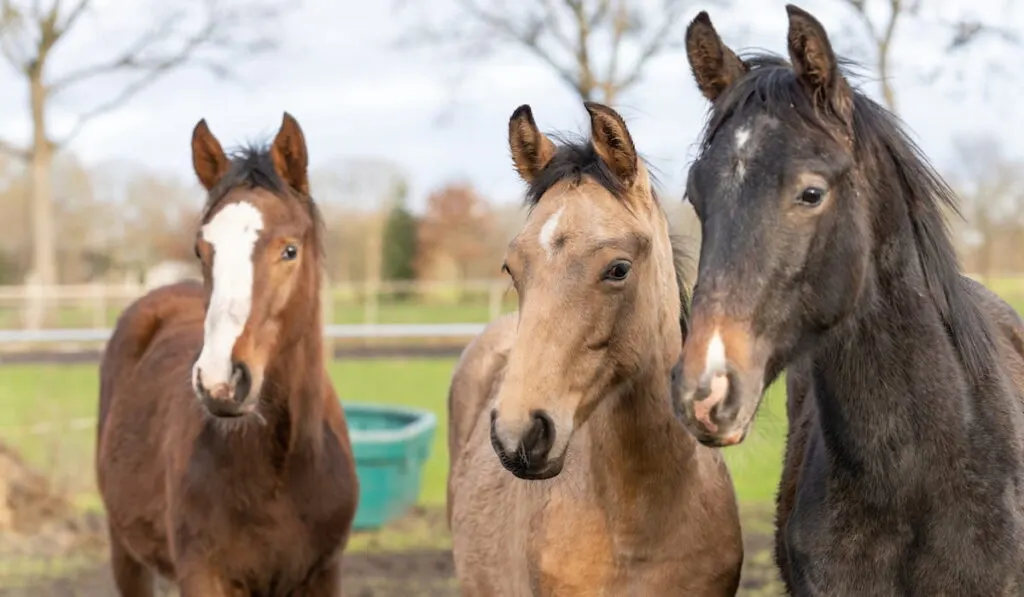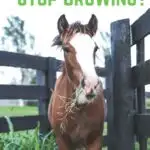When you are face to face with a cute little foal, it’s almost impossible to imagine that they will one day grow up to be the tall, rideable adult horses we know and love. However, we know that these babies will shoot up like a weed and fill out into strong, adult horses. But just when does that growth spurt stop? We know horses, like humans, reach a maximum height, but just when does that occur?

When do horses stop growing? Like most things with horses, there is no one definitive timetable for when horses stop growing. A variety of factors including age, breed, genetics, and management work together to influence how tall a horse will ultimately be.
Table of Contents
Age and Growth Statistics
There wide disparity in when horses stop growing. A lot of horses will top out in height at around 4 or 5 years of age, while others may still continue to grow until they are 8 years old.
Across breeds, the majority of them will reach approximately 90% of their full adult height by the time they are 2. The remaining 10% of growth takes place over the next 2 or so years.
Often it is the larger breeds (draft horses especially) that will continue growing up until 8 years old.
In terms of skeletal system growth, horses’ bones (aside from the skull) come with growth plates on either end of each bone, facilitating bone growth. These plates, comprised of cartilage, are able to stretch out as the horse grows.
Once the final height has been reached, that cartilage hardens into permanent, hard bone. Those cartilage plates generally fuse into bone when a horse is around 4 years old, but the vertebral column plates take longer, usually happening around 5 ½ years old or older.
Growth, though, isn’t all physical. A horse not only needs to reach a mature height, but they need to reach an emotional maturity as well. Most horses tend to reach emotional maturity somewhere around 5 and 7 years old.
Training horses too heavily before they are emotionally ready can lead to problems down the road, including anxiousness, negative associations with work, and behavioral outbursts in reaction to commands, such as bolting, kicking or rearing.

Growth Differences
Different breeds often exhibit different growth rates. For example, Quarter Horses and Thoroughbreds usually become fully grown at the age of 4 or 5 years old.
On the other hand, Arabians tend to reach full height later on, at around 6 years of age. Interestingly, their skeletons include one less vertebrae and one less set of rib bones than other horses, leading them to fully develop more slowly. Draft horses continue growing until around 5 to 8 years of age.
When they are foals, horses are only approximately only 10% of their ultimate body weight. Further studies done by Dr. Harold Hintz of Windfields Farm followed 1,992 foals from birth up to 22 months old. They found that Thoroughbreds and other light breeds generally reach 84% of their mature height by 6 months old.
That means, for example, an adult Thoroughbred that will be 16 hands at full growth will be about 13.2 hands at 6 months old. After that first two year growth spurt, mature growth happens at a much slower rate.
While the general pattern of growth is consistent across all equines, the ratios do tend to vary across breeds and sizes.
For example, mini horses and small, stocky ponies (such as Shetlands) tend to complete their growth spurt faster, and so present a more even trajectory to full grown height.
Draft horses take longer, up to 8 years, and so their rate of growth shows an ongoing increase year over year, when other lighter horses are already reaching top height.

How Do You Know When a Horse Is Finished Growing?
The easiest way to know when your horse has stopped growing is to be constantly tracking their height, so you can see when they reach a plateau. You can take regular measurements simply using a tape measure, although there are special measuring sticks designed specifically for horses..
To measure a horse’s height, make sure your horse is standing on flat, solid ground. Set the base of a tape measure on the ground beside your horse’s shoulder. Without bending it, stretch the tape straight up to be even with the top of their withers.
Take that measurement in inches and divide it by 4 to determine the number of “hands.” Horses are typically measured in hand, and 1 hand equals 4 inches.
By tracking your horse’s height regularly, you will be able to note when their growth seems to be slowing down and eventually stops altogether.
When determining height and growth, it’s important to make sure your horse’s hooves are in good condition, especially as their hooves are still growing as well.
The hooves of a horse play an important role in ensuring evenly distributed body weight and proper fluid circulation, as well as providing solid traction.

When it comes to predicting final height, there are a variety of ways to guess, but there’s no perfectly accurate method. For a rather simplistic method that just takes into account current height by age, there are some handy online calculators that can project an estimation.
Taking a look at parentage, too, can be a good indicator. If the foal’s body structure and their leg length look to be more like their mom than their dad, they will also most likely mirror them more closely in terms of height, as they will probably have inherited that growth gene.
Since a good amount of growth happens in the first two years, you can generally assume that their 24-month-old height is 90% of what their final height will be. If your horse is already a pretty tall specimen at this point, you can feel relatively certain that you will have a tall horse after the next few years.
A foal’s legs, too, can provide some key clues as to their future height. Foals look as lanky and gangly as they do because they are pretty much all leg! That means the length of legs they have as a weanling or yearling will be roughly the same as when they are an adult.
A very long-legged youngster will most likely grow into a taller adult!
This is the premise for the ‘string test’. Once a horse is about 18 months old, the distance from their fetlock to their elbow will be about the same as the distance from their elbow to their withers will be. Since horses stop growing ‘from the ground up’, this is one way to get an estimate of how tall your horse might end up.
Mares vs. Geldings
In general, female horses and male horses reach full height around the same time; at around 4 – 5-years of age. However, this is true more for mares and stallions.
A horse that has been gelded tends to grow faster, meaning they will grow bigger and stronger more quickly than their non-gelded counterparts. And the earlier a male horse is gelded, the taller he will likely grow.
A variety of factors determines horse height and speed of growth, so their sex is but one of a number of influences. Genetics, breeding and even quality and amount of feed will affect how tall your horse ends up!
Why You Should Wait to Ride
Full growth is essential to a horse’s long and healthy life. Though some industries – such as racing – begin training and riding their horses from a very young age (well before they are two years old), without professional care that can lead to long term skeletal damage.
For training and riding your own horse, you do not have to wait the full 5 years for every bone to be fully fused, but it is advised to hold off on riding them too soon.
Too much work or load carrying on a skeletal system that is still developing can cause damage to the legs or the growth plates including crushed cartilage, spinal problems, a slipped back, etc. Beyond bone problems, too, muscle issues can arise.
Horses who are worked too early may have trouble understanding what you are asking them to do – they are not mentally ready to understand complex commands, and this creates frustration and mental adversity, too.
For this reason, many experts recommend waiting until a horse is at least 4 years old, if not closer to 6 to begin riding.
Even in an industry (like racing) that favors training and riding before horses are 2, trainer John Shirreffs held off on entering Zenyatta in races until she was 4.
This is when many racehorses are reaching retirement, but for Zenyatta, this may have contributed to a strong and healthy horse that went undefeated for 20 races.
Just because many Thoroughbreds are ridden and raced by 2 doesn’t make it safe. In fact, many racehorses are retired by ages 6 or 7 due to health problems or injuries as a result of having been raced too early.
Resources
- https://mitavite.com/projected_height_calculator


